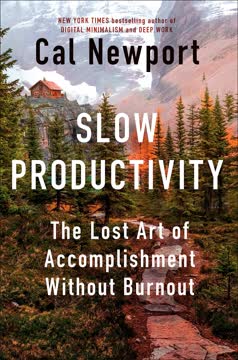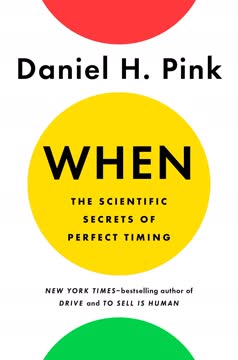نکات کلیدی
۱. تعیین مرزهای واضح و تمرکز بر یک کار در هر زمان
چشمانداز روشن به اندازهی آنچه انجام میدهید، دربارهی آنچه انجام نخواهید داد نیز اهمیت دارد.
تمرکز بر بهرهوری. تعیین مرزهای مشخص و تمرکز بر یک کار در هر زمان، از اصول بنیادین مدیریت مؤثر زمان است. با محدود کردن فعالیتها و تعهدات خود، چارچوبی برای افزایش بهرهوری و کاهش استرس ایجاد میکنید. این روش از احساس سردرگمی جلوگیری کرده و امکان تمرکز عمیقتر بر وظایف را فراهم میآورد.
مزایای محدودیت:
- بهبود تمرکز و کیفیت کار
- کاهش آشفتگی ذهنی و خستگی تصمیمگیری
- افزایش احتمال اتمام وظایف
- تعادل بهتر بین کار و زندگی
اجرای این اصل نیازمند تلاش آگاهانه برای گفتن «نه» به فعالیتها و حواسپرتیهای غیرضروری است. بهطور منظم تعهدات خود را بازبینی کرده و مواردی را که با اهداف یا ارزشهای اصلی شما همخوانی ندارند حذف کنید. به یاد داشته باشید، هر «بله» به یک چیز، «نه» به چیز دیگری است.
۲. ایجاد فاصله میان محرک و واکنش
شکایت از کمبود زمان مانند ماهیای است که در دریا از کمبود آب گله میکند.
واکنشی در برابر پیشدستانه. ایجاد فاصله میان محرک و واکنش برای حفظ کنترل بر زمان و رفتارها حیاتی است. این اصل شامل توقف کوتاه پیش از واکنش به وظایف، درخواستها یا اطلاعات جدید است تا بتوانید تصمیمات دقیقتر و استراتژیکتری بگیرید.
روشهای ایجاد فاصله:
- پردازش ایمیلها و پیامها در زمانهای مشخص
- استفاده از «منطقه نگهداری» برای وظایف جدید پیش از افزودن به فهرست اصلی
- رعایت «قاعده ۲۴ ساعته» پیش از قبول درخواستهای جدید
با ایجاد این فاصلهها، احتمال وقفههای مکرر و کشیده شدن به جهات مختلف کاهش مییابد. این روش به حفظ تمرکز بر اولویتها کمک کرده و از تبدیل روز به مجموعهای از واکنشهای فوری به محرکهای بیرونی جلوگیری میکند.
۳. اجرای سیستم «فردا انجام بده»
هیچ کاری آنقدر فوری نیست که نتوان آن را به فردا موکول کرد.
تعویق ساختاریافته. سیستم «فردا انجام بده» روشی قدرتمند برای مدیریت وظایف روزانه و کارهای ورودی است. این روش شامل جمعآوری تمام وظایف روزانه و پردازش آنها در روز بعد است که فاصلهای طبیعی ایجاد کرده و امکان کار منظمتر و مؤثرتر را فراهم میکند.
اجزای کلیدی سیستم:
- جمعآوری تمام کارهای ورودی (ایمیلها، پیامهای صوتی، وظایف) در طول روز
- پردازش کارهای دیروز به صورت دستهای در روز بعد
- استفاده از فهرست «کارهای انجامدادنی» به جای فهرست سنتی
- نگهداری فهرست جداگانه برای وظایف واقعاً فوری همان روز
این سیستم به کاهش احساس غرقشدگی در برابر حجم کار ورودی کمک کرده و امکان برنامهریزی و اولویتبندی بهتر را فراهم میآورد. همچنین چرخه وقفههای مکرر و کار واکنشی را میشکند و به افزایش بهرهوری و کاهش استرس منجر میشود.
۴. استفاده از فهرستهای بسته برای افزایش کارایی
فهرست بسته روشی برای اعمال محدودیت بر کارهای ما به منظور افزایش کارایی است.
تمرکز محدود. فهرستهای بسته ابزاری قدرتمند برای افزایش کارایی و حفظ تمرکز هستند. برخلاف فهرستهای باز که میتوانند بیپایان رشد کنند، فهرستهای بسته مجموعهای مشخص از وظایف دارند که پس از ایجاد، امکان افزودن به آنها وجود ندارد. این محدودیت باعث تشویق به اتمام کارها و کاهش تغییر مکرر اولویتها میشود.
مزایای فهرستهای بسته:
- احساس واضحتر پیشرفت و موفقیت
- کاهش خستگی تصمیمگیری
- افزایش احتمال اتمام وظایف
- تخمین و برنامهریزی بهتر زمان
برای اجرای فهرستهای بسته، فهرست روزانه «کارهای انجامدادنی» با تعداد واقعبینانهای از وظایف که در یک روز قابل انجام هستند، تهیه کنید. پس از ایجاد فهرست، از افزودن موارد جدید تا پایان فهرست فعلی خودداری کنید. این روش به حفظ تمرکز کمک کرده و از جابهجایی مکرر اولویتها که معمولاً در فهرستهای سنتی رخ میدهد، جلوگیری میکند.
۵. تمایز میان کار واقعی و کار بیهوده
کار بیهوده اغلب بیشتر شبیه کار واقعی به نظر میرسد تا خود کار واقعی.
بهرهوری معنادار. تمایز میان کار واقعی و کار بیهوده برای به حداکثر رساندن بهرهوری و دستیابی به اهداف مهم ضروری است. کار واقعی کسبوکار یا حرفه شما را پیش میبرد، مهارتهای شما را بهکار میگیرد و اغلب شما را از منطقه راحتی خارج میکند. در مقابل، کار بیهوده ممکن است احساس مفید بودن ایجاد کند اما به اهداف اصلی شما کمک چندانی نمیکند.
ویژگیهای کار واقعی در برابر کار بیهوده:
کار واقعی:
- تأثیر مستقیم بر نتایج یا اهداف کلیدی دارد
- نیازمند مهارتها و تخصص منحصر به فرد شماست
- اغلب چالشبرانگیز یا خارج از منطقه راحتی است
کار بیهوده:
- احساس مفید بودن دارد اما اهداف کلیدی را پیش نمیبرد
- قابل واگذاری یا حذف است
- اغلب برای اجتناب از وظایف دشوارتر استفاده میشود
فعالیتهای خود را بهطور منظم ارزیابی کنید تا مطمئن شوید بر کار واقعی تمرکز دارید. صادقانه بررسی کنید کدام وظایف واقعاً ضروریاند و کدام فقط شما را مشغول نگه میدارند. کار بیهوده را حذف یا واگذار کنید تا زمان بیشتری برای فعالیتهای مؤثرتر داشته باشید.
۶. غلبه بر تعویق با رویکردهای ساختاریافته
دروغ گفتن ویژگی ذهن منطقی است.
فریب استراتژیک خود. غلبه بر تعویق نیازمند درک سازوکارهای روانشناختی آن و بهکارگیری روشهای ساختاریافته برای مقابله با آن است. یکی از تکنیکهای مؤثر، «فریب» ذهن واکنشی با وانمود کردن به عدم انجام کار مقاومتبرانگیز در حالی است که گامهای کوچکی به سوی آن برمیدارید.
روشهای غلبه بر تعویق:
- استفاده از عبارت «الان واقعاً نمیخواهم [کار] را انجام دهم، اما فقط یک قدم کوچک برمیدارم»
- کار در بازههای زمانی مشخص (مثلاً ۲۵ دقیقه کار متمرکز و ۵ دقیقه استراحت)
- تقسیم وظایف بزرگ به گامهای کوچکتر و کمتر ترسناک
- استفاده از گفتوگوی درونی مثبت و تکنیکهای بازتعریف
به یاد داشته باشید که تعویق اغلب ریشه در احساس غرقشدگی یا ترس از شکست دارد. با بهکارگیری این روشهای ساختاریافته، میتوانید مقاومت عاطفی را دور زده و پیشرفت مستمری در وظایف مهم داشته باشید.
۷. اولویتبندی پروژهها به ترتیب معکوس فوریت
باور ندارم کسی بتواند همیشه بر اساس اهمیت اولویتبندی کند، چون عملاً انجام آن غیرممکن است.
برنامهریزی پیشدستانه. اولویتبندی پروژهها به ترتیب معکوس فوریت رویکردی غیرمنتظره اما مؤثر برای مدیریت چند پروژه است. این روش شامل پرداختن به وظایف کمفوریتتر ابتداست که از تبدیل آنها به موارد فوری جلوگیری کرده و استرس و شتابزدگیهای آخرین لحظه را کاهش میدهد.
مزایای اولویتبندی معکوس فوریت:
- کاهش بحرانهای ساختگی
- بهبود کیفیت کار با اختصاص زمان بیشتر به وظایف مهم
- کاهش استرس با توزیع یکنواختتر کار
- افزایش بهرهوری و کارایی کلی
برای اجرای این روش، پروژههای خود را بهطور منظم بازبینی کرده و آنهایی را که مهلتهای دورتری دارند شناسایی کنید. بهطور مستمر زمانی برای کار روی این پروژهها اختصاص دهید، حتی اگر فوریت نداشته باشند. این رویکرد پیشدستانه از انباشت بحرانهای آخرین لحظه جلوگیری کرده و امکان انجام کارهای با کیفیت و دقیقتر را فراهم میکند.
۸. واگذاری مؤثر برای افزایش بهرهوری
هیچکس هرگز کاری را با اولویتی بالاتر از آنچه شما به آن میدهید، انجام نخواهد داد.
توانمندسازی دیگران. واگذاری مؤثر برای افزایش بهرهوری و دستیابی به اهداف بزرگتر حیاتی است. این کار تنها به معنای تخصیص وظایف نیست، بلکه شامل توانمندسازی دیگران برای پذیرش مسئولیت و توسعه مهارتهایشان نیز میشود. واگذاری صحیح زمان شما را برای انجام وظایف سطح بالا آزاد کرده و قابلیتهای تیم را ارتقا میدهد.
کلیدهای واگذاری مؤثر:
- واگذاری وظایف در اسرع وقت، نه در آخرین لحظه
- ارائه دستورالعملها و انتظارات واضح
- تعیین مهلتهای واقعبینانه با حاشیههای زمانی مناسب
- پیگیری منظم بدون مدیریت بیش از حد
- ارائه حمایت و منابع لازم
به یاد داشته باشید که واگذاری مهارتی است که با تمرین بهبود مییابد. از انجام همه کارها بهتنهایی خودداری کنید، حتی اگر در کوتاهمدت سریعتر به نظر برسد. واگذاری مؤثر به افزایش بهرهوری بلندمدت و تیمی توانمندتر منجر میشود.
آخرین بهروزرسانی::
FAQ
What's "Do It Tomorrow and Other Secrets of Time Management" about?
- Overview of the book: "Do It Tomorrow and Other Secrets of Time Management" by Mark Forster is a guide to improving personal productivity by rethinking traditional time management techniques.
- Core concept: The book introduces the "mañana principle," which suggests handling today's tasks tomorrow to create a buffer and reduce randomness.
- Focus on closed lists: Forster emphasizes using closed lists to manage tasks, which helps in completing daily work efficiently without being overwhelmed by new tasks.
- Practical advice: The book provides practical methods for dealing with backlogs, setting priorities, and maintaining focus on real work versus busy work.
Why should I read "Do It Tomorrow and Other Secrets of Time Management"?
- Unique approach: The book offers a fresh perspective on time management, challenging traditional methods like prioritizing by importance and using open to-do lists.
- Practical solutions: It provides actionable strategies to manage daily tasks, reduce stress, and increase productivity by focusing on completing a day's work within a day.
- Improves efficiency: Forster's methods aim to enhance processing power and efficiency, helping readers to work smarter, not harder.
- Real-life applications: The book is filled with examples and exercises that can be directly applied to personal and professional life, making it highly relevant for anyone looking to improve their time management skills.
What are the key takeaways of "Do It Tomorrow and Other Secrets of Time Management"?
- Mañana principle: Handle today's tasks tomorrow to create a buffer, allowing for better planning and reduced interruptions.
- Closed lists: Use closed lists to manage tasks, ensuring that all items are completed without the distraction of new tasks being added.
- Focus on real work: Distinguish between real work that advances goals and busy work that merely fills time.
- Daily completion: Aim to complete a day's worth of work each day, using structured systems to maintain control and efficiency.
How does Mark Forster's "mañana principle" work?
- Buffer creation: The principle involves collecting all tasks for the day and planning to complete them the next day, creating a buffer that allows for better organization.
- Reduces randomness: By planning tasks for tomorrow, you minimize the impact of random interruptions and can focus on completing tasks systematically.
- Closed list advantage: Tasks are handled in closed lists, which are easier to manage and complete compared to open lists that grow throughout the day.
- Improves planning: This approach allows for more accurate daily planning, as you know exactly what needs to be done without the pressure of immediate tasks.
What is the difference between "real work" and "busy work" according to Mark Forster?
- Real work definition: Real work is what advances your business or job, uses your skills fully, and often takes you out of your comfort zone.
- Busy work characteristics: Busy work consists of tasks that avoid real work, often underutilizing your skills and keeping you within your comfort zone.
- Impact on productivity: Focusing on real work leads to meaningful progress and achievement, while busy work can lead to inefficiency and stagnation.
- Decision-making: Forster advises making conscious decisions to focus on real work and avoid taking on commitments that lead to busy work.
How does Mark Forster suggest dealing with backlogs?
- Declare a backlog: Forster recommends declaring a backlog by isolating all outstanding tasks and dealing with them separately from new tasks.
- Use closed lists: Backlogs should be managed using closed lists, which prevent new tasks from being added and allow for systematic clearing.
- Prioritize backlog clearing: Make clearing the backlog a current initiative, focusing on it first each day until it is resolved.
- Avoid future backlogs: Ensure that systems are in place to handle new tasks efficiently, preventing the accumulation of future backlogs.
What role do "closed lists" play in "Do It Tomorrow and Other Secrets of Time Management"?
- Definition: A closed list is a list of tasks that is not open to new additions, allowing for focused completion of all items.
- Efficiency: Closed lists help in managing tasks more efficiently by preventing the distraction of new tasks being added throughout the day.
- Daily completion: They support the goal of completing a day's work within a day, as all tasks are known and finite.
- Application: Forster suggests using closed lists for emails, voicemails, paper tasks, and other daily activities to maintain control and reduce stress.
How does Mark Forster recommend handling tasks and projects?
- Task diary: Use a task diary to schedule tasks for specific days, ensuring that they are completed systematically.
- Current initiative: Focus on one current initiative at a time, working on it first each day to ensure progress.
- Project breakdown: Break projects into smaller tasks and schedule them in the task diary, allowing for manageable progress.
- Continuous projects: For repetitive projects, establish a daily habit or routine to ensure consistent progress over time.
What are some of the best quotes from "Do It Tomorrow and Other Secrets of Time Management" and what do they mean?
- "To complain about a shortage of time is like a fish in the sea complaining that it has a shortage of water." This quote emphasizes that time is abundant, and the issue lies in how we manage it, not in its scarcity.
- "The art of getting everything done by putting it off to tomorrow." This encapsulates the mañana principle, highlighting the strategic delay of tasks to improve planning and reduce stress.
- "Real work often involves a lot of thinking and planning." This quote distinguishes real work from busy work, emphasizing the importance of thoughtful action over mere activity.
- "If you have too much work, it’s coming from too many commitments." Forster stresses the need to evaluate and reduce commitments to manage workload effectively.
How does Mark Forster address procrastination in "Do It Tomorrow and Other Secrets of Time Management"?
- Procrastination causes: Forster identifies feelings of being overwhelmed and behind as primary causes of procrastination.
- Prevention strategies: He suggests using closed lists and the mañana principle to stay on top of tasks and reduce the likelihood of procrastination.
- Overcoming resistance: Techniques like working in timed bursts and fooling the reactive mind help overcome initial resistance to tasks.
- Focus on structure: Maintaining a structured approach to daily tasks and projects helps prevent procrastination by providing clear direction and goals.
What is the "current initiative" concept in "Do It Tomorrow and Other Secrets of Time Management"?
- Definition: The current initiative is a focus on one priority task or project that is worked on first each day.
- Daily focus: By working on the current initiative first, you ensure that important tasks receive attention before other daily activities.
- Types of initiatives: Current initiatives can include clearing backlogs, sorting out defective systems, or getting new projects up and running.
- Completion: The initiative remains the focus until it is completed, ensuring consistent progress and preventing stagnation.
How does Mark Forster suggest improving efficiency in "Do It Tomorrow and Other Secrets of Time Management"?
- Closed lists: Use closed lists to manage tasks, reducing distractions and improving focus on completing daily work.
- Batch processing: Handle similar tasks in batches, such as emails and voicemails, to increase processing speed and efficiency.
- Avoid overscheduling: Leave adequate unscheduled time to handle daily tasks and prevent overwhelm.
- Audit procedure: Regularly audit your work to identify inefficiencies, excessive commitments, or insufficient time, and make necessary adjustments.
نقد و بررسی
کتاب «فردا انجامش بده و دیگر رازهای مدیریت زمان» بهخاطر رویکرد ساده اما مؤثرش در افزایش بهرهوری، از سوی خوانندگان با تحسین فراوانی مواجه شده است. بسیاری از منتقدان اصول مطرحشده در این کتاب را تحولآفرین دانستهاند، بهویژه مفاهیمی مانند فهرستهای بسته، کاهش تصادفیکاری و به تعویق انداختن وظایف غیرضروری. خوانندگان از دیدگاه منحصربهفرد فورستر در مدیریت زمان که با توصیههای سنتی تفاوت دارد، استقبال کردهاند. اگرچه برخی از ایدهها را دشوار برای اجرا یافتهاند، اما اکثریت بر این باورند که کتاب بینشهای ارزشمندی برای بهبود عادات کاری و کاهش استرس ارائه میدهد. سادگی و کاربردی بودن این سیستم بهطور مکرر بهعنوان نقاط قوت برجسته شده و بسیاری از خوانندگان از بهبود چشمگیر در بهرهوری و تعادل بین کار و زندگی خود گزارش دادهاند.
Similar Books















